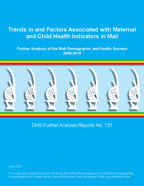There is no printed copy available to order.
Abstract:
This paper examines fifteen maternal and child health indicators using the three most recent Demographic and Health Surveys (DHS) conducted in Mali (2006, 2012-13, and 2018). These indicators include antenatal care, postnatal care, delivery in a health facility, Caesarean section delivery, vaccination among children, and care-seeking for acute respiratory infection, fever, and diarrhea for children. The analysis includes examination of overall trends, trends by background variables, and regressions for the most recent survey. One main finding was the lack of improvement in several indicators between the 2012 and 2018 surveys, which coincides with the conflict that began in Mali in 2012. This was especially relevant for antenatal care visits, vaccination, and care-seeking for diarrhea. Large gaps in these indicators were found in the conflict areas, especially in Kidal and Tombouctou, when compared to the other regions. Caesarean section delivery remained low across all background variables and has remained between 2-3% since 2006. This indicates a need for more accessible emergency obstetric care for women and increased awareness of the importance of recognizing danger signs. There were also some indicators that showed improvement between the two most recent surveys. These included delivery in a health facility, postnatal care for the mother, acute respiratory infection, fever care-seeking, and all antenatal components except for having at least two tetanus toxoid injections, which remained unchanged. Almost all indicators showed large disparities by background variables, with the largest in wealth quintile, region, and education level. This highlights the need for services, interventions, and increased awareness that can reach the poorest households and least-educated women in Mali.
 Trends in and Factors Associated with Maternal and Child Health Indicators in Mali (PDF, 4946K)
Trends in and Factors Associated with Maternal and Child Health Indicators in Mali (PDF, 4946K)
